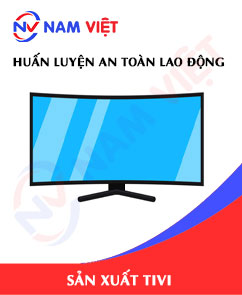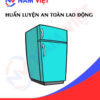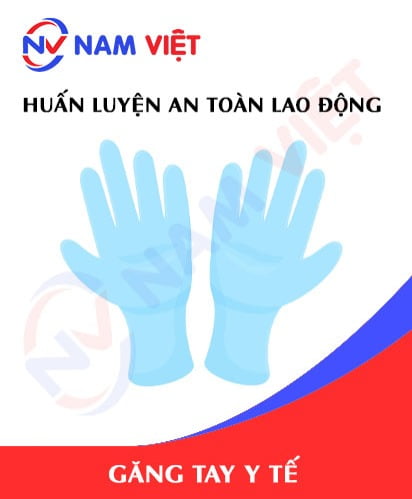Occupational Safety Training For Television Manufacturing
99,000 ₫
Note: The above price is calculated for one person, the price may fluctuate depending on the number of trainees participating in the course and the movement of the market. For more accurate pricing support, please refer to the quotation or contact directly with our consultants.
Occupational safety is an important issue in television manufacturing factories and needs to be addressed promptly to ensure the health and safety of workers, as well as to enhance the reputation of enterprises. The Occupational Safety Training course is one of the effective solutions to raise awareness about preventing occupational accidents for workers participating in television manufacturing.
Table of Contents
Toggle1. Overview of Television
a. What is a Television?
A television is an electronic device used to watch television programs or movies. It has a screen that displays images, sound, and connection ports to connect with other devices such as computers, DVD players, or television terminals. Television is commonly used in households, stores, shopping centers, hotels, conferences, and other public areas.

b. Types of Machinery for Television Manufacturing
The process of television manufacturing involves various machines and equipment to complete each production step. Below are some machines commonly used in the television manufacturing process:
- Screen cutting machine: Used to cut the screen into the desired size and shape.
- Screen component pressing machine: Used to press the screen components together.
- Television casing cutting machine: Used to cut casing pieces of the television into the desired size and shape.
- Television casing pressing machine: Used to press the casing pieces of the television together.
- Platinum welding machine: Used to weld the television components together.
- Component assembly machine: Used to assemble components inside the television.
- Printing machine for letters and images on television: Used to print letters and images on the front of the television.
- Quality inspection machine: Used to check the quality of the television before leaving the factory.
- Packing machine: Used to pack and prepare products for transportation.
However, the specific types of machines may vary depending on the manufacturing process and the technical requirements of each manufacturer.

c. Television Manufacturing Enterprises in Viet Nam
Currently, there are many television manufacturing brands worldwide, among which the most famous brands include:
- Samsung: one of the most famous brands in the field of television with many high-quality product lines, diverse in size, design, and features.
- LG: also one of the leading television brands in the world with products featuring luxurious designs, diverse functions, and high resolution.
- Sony: known as a brand specializing in manufacturing quality televisions, with products that have eye-catching designs, sharp screens, smart features, meeting customer demands.
- Panasonic: provides quality television product lines with simple designs, smart features, and high resolution.
- Philips: manufactures televisions with various product lines, attractive designs, smart structures, and diverse features.
In addition, there are other television brands such as Sharp, TCL, Hisense, Toshiba, Vizio, etc.

d. Specific Jobs in a Television Manufacturing Factory
Group 1
- Chief executive officer, deputy executive officer, department heads in a television manufacturing factory.
Group 2
- Safety officer: manage safety in the factory, design safety procedures, supervise and enforce employees to comply with safe working procedures.
Group 3
- Component purchasing: An important part of television manufacturing is the components. Television manufacturers must seek reliable and high-quality component suppliers to ensure the best product quality.
- Electronic circuit board manufacturing: This work requires special expertise since manufacturing electronic boards must comply with strict process and quality requirements.
- Assembly: The assembly process of televisions includes attaching components to their positions on the circuit board and inside the television casing.
- Quality inspection: During manufacturing, products are inspected to ensure proper operation and compliance with quality standards.
- Packing and transportation: After quality inspection, products are packed and transported to stores or warehouses for distribution to customers.
Group 4
- Office work, services, sales, marketing.
- Production management, quality management, human resources management, materials management, financial and accounting management.
- Product design: The team of technicians designs new television models, ensuring they meet customer needs and market trends.

2. Overview of Occupational Safety Training for Television Manufacturing
In this article, we focus on group 3, because group 3 is the group directly involved in the manufacturing process, facing the highest occupational safety risks. Refer to other groups here
a. What is Group 3 Occupational Safety Training?
- Occupational safety training group 3 consists of lessons that provide awareness of accident prevention for workers.
- The occupational safety training course will help workers identify and prevent hazards, reducing the risk of accidents while working.
REGISTER FOR OCCUPATIONAL SAFETY TRAINING SERVICE
b. Training Duration
Initial safety training duration
- Total training duration is at least 24 hours, including examination time.
- 8 hours of theoretical learning about the system of policies and laws on occupational safety and hygiene
- 8 hours of theoretical learning about basic knowledge of occupational safety and hygiene
- 4 hours of theoretical learning about specialized training content
- 2 hours of practical training on specialized training content
- 2 hours of theoretical examination at the end of the course
The occupational safety training center will schedule multiple training sessions depending on the workers’ study schedule. Typically, there will be 6 training sessions, the course will last for 3 days, provided that the manufacturing enterprise arranges continuous learning time.
Periodic safety training duration
- Before the occupational safety card expires, workers who wish to renew must undergo a periodic occupational safety training course, with periodic training duration being at least 50% of the initial training duration.
Explanation: the total periodic occupational safety training duration is at least 12 hours, including examination time. After completing the periodic training and passing the test, workers will be reissued or extended their occupational safety card.
c. Training Course Content
| No. | TRAINING CONTENT | TRAINING DURATION (HOURS) | |||
| Total | Including | ||||
| Theory | Practice | Examination | |||
| I | System of policies and laws on occupational safety and hygiene | 8 | 8 | 0 | 0 |
| 1 | Overview of the system of legal documents on occupational safety and hygiene. | 6 | 6 | ||
| 2 | System of standards and technical regulations on occupational safety and hygiene. | 1 | 1 | ||
| 3 | Specific regulations of state management agencies on occupational safety and hygiene when constructing new, expanding, or renovating facilities for manufacturing, using, storing, keeping, and inspecting machines, equipment, materials, and substances subject to strict occupational safety and hygiene requirements. | 1 | 1 | ||
| II | Basic knowledge of occupational safety and hygiene | 8 | 8 | 0 | 0 |
| 1 | Basic knowledge of hazardous and harmful factors in the workplace. | 4 | 4 | ||
| 2 | Methods of improving working conditions. | 1 | 1 | ||
| 3 | Safety culture in manufacturing and business. | 1 | 1 | ||
| 4 | Rights and obligations of employers and workers; policies and regimes on occupational safety and hygiene for workers; functions and tasks of the safety and hygiene network. | 1 | 1 | ||
| 5 | Occupational safety and hygiene regulations, safety signs and instructions, use of safety equipment, personal protective equipment; professional skills in first aid for occupational accidents, prevention of occupational diseases. | 1 | 1 | ||
| III | Specialized training content | 6 | 4 | 2 | 0 |
| General knowledge of machines, equipment, substances generating hazardous and harmful factors; analysis, evaluation, and risk management of occupational safety and hygiene; safe working procedures with machines, equipment, substances requiring strict occupational safety and hygiene. | 6 | 4 | 2 | ||
| IV | Examination of training content at the end of the course | 2 | 2 | 0 | 0 |
| Total | 24 | 22 | 2 | ||
See more training content of 6 groups
d. Occupational Safety Card
After completing the occupational safety training and passing the test, workers will be issued an occupational safety card (commonly called occupational safety certificate group 3).
The group 3 safety card will clearly show information such as: full name, date of birth, job, and specific working environment. It also includes the training duration, red stamp, and signature confirming completion of the course.
According to the card issuance regulation stated in Clause 2 Article 24 of Decree 44/2016/ND-CP, there are 2 cases:
- In case the employer and the worker have a labor contract, then the employer must sign, stamp, and seal the safety card for the trained group 3 worker after completing the course from the occupational safety training unit and passing the test.
- In case of freelance or seasonal workers without a labor contract, the training unit must sign, stamp, and seal the safety card for the worker after completing the course from the occupational safety training unit and passing the test.

3. Recognizing Hazards Affecting Workers in Television Manufacturing
During the television manufacturing process, workers may face many hazards, including:
- Injuries caused by physical impact: Hazards such as collisions, impacts, falling heavy objects, or cuts, hand injuries when using machinery.
- Risk of radiation exposure: Electronic components in televisions may contain radioactive materials, especially in CRT televisions. Workers may be exposed to radiation if they do not wear adequate protective equipment and do not follow safety procedures.
- Risk of electric shock: High voltage and current in electronic components of televisions can cause danger to workers if safety measures are not properly implemented.
- Risk of contamination: Television manufacturing may involve toxic substances such as lead, mercury, chlorine… Workers may be exposed to these toxins if they do not wear adequate protective equipment and do not follow safety procedures.
- Risk of fire and explosion: Television manufacturing may involve chemicals, gases that are flammable and explosive. Workers may face fire and explosion risks if safety procedures are not followed.

4. Types of Occupational Accidents Commonly Occurring to Workers in Television Manufacturing
The types of occupational accidents that commonly occur to workers in television manufacturing may include:
- Collisions, falls: During the transportation or movement of large television parts, workers may collide or fall, causing bodily injuries.
- Machinery-related injuries: When operating machinery, workers may be stabbed, cut, burned, or crushed by machine parts.
- Chemical reactions: Chemicals used in the television manufacturing process may cause skin irritation or toxic gases harmful to workers’ health.
- Electrical injuries: During television assembly, workers may suffer electric shocks due to negligence or improper use of protective equipment.
- Noise-induced injuries: Television manufacturing often involves equipment that generates loud noise, potentially causing hearing damage if ear protection is not used.

5. Safety Measures When Participating in Television Manufacturing
Safety measures when participating in television manufacturing include:
- Ensure provision of personal protective equipment: Workers must be fully equipped with protective equipment such as helmets, safety glasses, gloves, safety shoes, masks, …
- Maintain correct working posture: Adjust proper posture while working to avoid muscle injuries, back pain, neck pain, hand numbness, …
- Use equipment and machinery properly: Operate equipment and machinery correctly, following the manufacturer’s instructions, ensuring safety for users and participants in the manufacturing process.
- Regular inspection and maintenance of equipment: Frequently inspect and maintain equipment and machinery to ensure proper operation and prevent incidents and accidents.
- Training and educating employees: Train and educate employees about occupational safety, proper use of equipment and machinery, and how to detect and handle hazardous situations to avoid incidents and accidents.
- Strict management of materials and chemicals: Manage materials and chemicals strictly to prevent incidents and accidents for workers during the manufacturing process.
- Ensure occupational hygiene: Maintain good occupational hygiene to prevent occupational diseases and environmentally caused illnesses.
- Periodically conduct workplace environmental monitoring in factories, collect and analyze harmful factors for workers, thereby adjusting and reducing risks to prevent occupational diseases.
6. Benefits of Occupational Safety Training in Television Manufacturing
An Toan Nam Viet provides your business with great benefits after completing occupational safety training courses in accordance with Decree 44/2016/ND-CP on occupational safety and hygiene, applicable to companies, factories, enterprises.
- Workers can recognize potential risks of occupational accidents and take preventive measures to avoid them.
- Your business can establish risk prevention measures in manufacturing, operating, and maintenance processes.
- Minimize costs when occupational safety risks occur.
- Uninterrupted manufacturing processes help increase labor productivity and product quality.
- Ensure compliance with occupational safety laws, avoiding legal risks.
- Create credibility and professionalism in all aspects, thereby enhancing the brand value of your business.
An Toan Nam Viet’s training courses are solutions to prevent and protect individuals from external factors that may lead to danger, injuries, or even fatalities.
REGISTER FOR OCCUPATIONAL SAFETY TRAINING SERVICE
7. Customer Feedback After Completing Occupational Safety Training in Television Manufacturing
An Toan Nam Viet has many years of experience in accompanying businesses in Vietnam in general and in the southern provinces in particular. This responsibility is extremely valuable to An Toan Nam Viet, which is why occupational safety training is always increasingly emphasized and professionalized. The motivation for An Toan Nam Viet’s strong development comes from the positive feedback and contributions of businesses. Below are feedbacks from our valued partners we have served.
Bac Nam E&C Construction Investment Joint Stock Company
“This is the first time using the service at An Toan Nam Viet and I was very surprised by the enthusiastic 24/7 support of the consulting team. The organization of the class was very quick and convenient for our company, thank you very much for An Toan Nam Viet’s service!”
Hoa Dat Construction and Trading Joint Stock Company
“An Toan Nam Viet’s service has helped us a lot in simplifying occupational safety and completing safety records for the working process. The consulting team was enthusiastic and timely in answering our questions. 5 stars for An Toan Nam Viet.”
See more customer interview sessions after using the service of An Toan Nam Viet
8. Occupational Safety Training Capacity of An Toan Nam Viet
An Toan Nam Viet is a prestigious and high-quality occupational safety training center in Vietnam today. Safety training sessions are continuously held at manufacturing workshops, factories, or construction sites nationwide (63 provinces and cities in Vietnam).
REGISTER FOR OCCUPATIONAL SAFETY TRAINING SERVICE
License for occupational safety training
- An Toan Nam Viet has been inspected and certified by the Department of Work Safety of the Ministry of Labor, War Invalids and Social Affairs as eligible to operate in occupational safety and hygiene training. This further strengthens our occupational safety training capacity.

Documents and lectures
- Before being used in occupational safety training courses, training documents are reviewed and approved to ensure accuracy and effectiveness when applied.
- Teaching methods of instructors are standardized according to An Toan Nam Viet’s teaching standards, developed and summarized by occupational safety experts to maximize knowledge absorption by trainees.
Facilities
- Controlling factors in classrooms that affect training will increase teaching efficiency and knowledge absorption by trainees.
- Our training support facilities always provide spacious classrooms meeting standards for area, lighting, and training equipment…
9. Prestigious Nationwide Occupational Safety Training Center
At An Toan Nam Viet, we always put our professional dedication to occupational safety training as the top priority. For us, imparting self-protection knowledge to workers so they can have safety tools in their livelihoods is a contribution to nation building.
To ensure effective training, we carefully prepare every detail, even the smallest, from teaching tools, equipment, and curriculum to documents, sound, and lighting.
Our occupational safety trainers are experts with many years of experience in the field. They even have research projects identifying hazards across all industries and preventive measures.
Lectures are summarized from practice and delivered vividly and clearly to workers. These factors help workers feel comfortable during learning and better absorb knowledge. Of course, the knowledge taught always adheres to Decree 44/2016/ND-CP.
From there, workers gain multiple measures to prevent hazards and protect themselves, while applying them appropriately in actual work.
Our safety training center is proud to provide prestigious, professional occupational safety training services with the following advantages:
- Competitive training costs while maintaining training quality.
- Flexible training schedules in line with the company’s manufacturing situation.
- Quick occupational safety training certification procedures, in compliance with legal regulations.
- Instructors with many years of professional experience.
- Classrooms controlled for factors affecting training, enhancing teaching efficiency and knowledge absorption.
- Lectures tailored to occupational safety practices in enterprises.
- An Toan Nam Viet works diligently and professionally to provide customers with accurate and fastest support.

10. Additional References for Occupational Safety Training in Television Manufacturing
- Occupational safety training materials set
- Occupational safety documents for television manufacturing
- Occupational safety training test set
- Occupational safety training curriculum for television manufacturing
- Occupational safety training multiple-choice test for television manufacturing
1 review for Occupational Safety Training For Television Manufacturing
No comments yet















namchinh.haiphong341
Dịch vụ huấn luyện an toàn lao động rất tốt nhé, giảng viên dạy rất sinh động dễ hiểu!